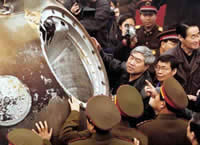|
|
Steady development was seen in the
scientific and technical contingent. At the end of 2000, the State-owned
enterprises and institutions nationwide had 29.26 million professionals
and technicians specialized in all disciplines, an increase of 0.75
percent over the end of 1999. A total of 2.81 million people were engaged
in scientific and technological activities, including 1.56 million
scientists and engineers.
New progress was achieved in technological
innovation. In 2000, the State organized 280 key techn ological
innovation projects and 1,329
projects for trial production of major new products. Research and
development of 101 items of key
technical equipment was completed and passed appraisal and proof-test.
Cooperation between enterprises and universities and research institutions
was further strengthened. In 2000, a total of 4.6 million people from
400,000 enterprises, universities and research institutions participated
in 140,000 cooperative projects. ological
innovation projects and 1,329
projects for trial production of major new products. Research and
development of 101 items of key
technical equipment was completed and passed appraisal and proof-test.
Cooperation between enterprises and universities and research institutions
was further strengthened. In 2000, a total of 4.6 million people from
400,000 enterprises, universities and research institutions participated
in 140,000 cooperative projects.
Fresh achievements were made in scientific research and
technological development. The year 2000 witnessed 30,260 major scientific
and technological achievements at and above ministry or provincial level.
These included 2,420 achievements in the research of basic theories,
26,020 results in applied technologies and 820 results for soft science.
About 300 achievements won State awards. A total of 170,690 domestic and
foreign patent applications were received, of which 105,344 patents were
authorized, an increase of 27.2 and 5.2 percent respectively. Technology
market became more brisk. In 2000, a total of 265,000 technology contracts
were signed, involving a transaction value of 63 billion yuan, up 20
percent over the previous year.
New headway was scored in space technology, with six
successful launches of satellites in 2000.
Further improvement was made in technical services such as
quality inspection, standardization, metrology and weather forecast. At
the end of 2000, China had 5,500 product quality inspection institutions,
including 230 national inspection centers. Authorized institutions
conducted selective examinations of 9,705 kinds of products in 235
categories from 8,142 enterprises. There were 59 quality authentication
institutions, including 23 product authentication institutions, which
provided product authentication service to 13,194 enterprises nationwide.
There were also 4,505 legal measurement inspection institutions and
compulsory verification tests were made on 40.69 million sets of measuring
instruments. A total of 1,087 national standards were formulated or
amended, including 196 compulsory national standards and 605 new national
standards. There were 951 urban and rural weather forecast transmission
stations, 315 satellite cloud picture receiving stations, 1,234 seismic
stations and 27 remote sensing stations and networks. The country's 927
ocean observation and monitoring stations obtained 20.7 million sets of
oceanographic data. Surveying and mapping departments published 1,150
kinds of maps and 364 titles of books.
|
|